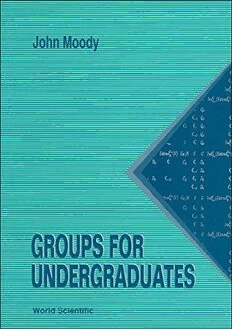
Groups for Undergraduates PDF
Preview Groups for Undergraduates
GroufpoUsrn dergraduates GROUPSF OR UNDGREARADTUSE JohAnt Mwoeoldly WarwicUkn iversity UnitKeidn gdom 'i, WorlSdc ientific II Singapore• NeLwo nJd•eoH rnosnKegoy n•g Publibys hed World Scientific Publishing Co. Pte. Ltd. PO Box 128, Farrer Road, Singapore 9128 USAo fficeSu:ite lB, 1060 Main Street, River Edge, NJ 07661 UKo fficePO: B ox 973, London Nl2 7JS GROUPS FOR UNDERGRADUATF.S Copyright© 1994 by World Scientific Publishing Co. Pte. Ltd. Alrli grhetss eThrviebsdo .o ok,rp arthtse remayo f,n obter eproidannuy cf eodrm obyr anmye anesle,c troomernc ihanci cianlc,l puhdoitnogc roepcyoirondianrgn y,g informatsitoonran adgr ee trsyisetvenaomlwkn owonr t ob ei nvewnittehd,o ut writtpeenrm isfsriotomhnP e u blisher. For photocopying of material in this volume, please pay a copying fee through the Copyright Clearance Center, Inc., 27 Congress Street, Salem, MA 01970, USA. ISBN 981-02-1557-6 ISBN 981-02-2105-3 (pbk) PrinitneS di ngapboyUr teo- Print Contents Preface .......................................................................... vii Author's message to the student ................................i x Chapter 0. Introduction ................................................ 1 Represent(abtaisdoiencfis n itions)-Cloasfps eirfimcuation tatiroenp resentations Chapter 1. Number-Theoretic Preliminaries ........... 10 Binomitahle orem-CThhien eRseem aindTehre orem Sylotwh eoremss-tTrhuec otf.Zu /rne .zx_FiniFtiee lds Thec onjugcalcays isneG sl m(.Z/p.Z)-Polyfnaocmtioarl izatainodfin n ifiteel ds Chapter 2. Semidirect Products ................................ 43 Chapter 3. Presentations ............................................ 4 7 Presentaotfsi eomnisd iprreocdtu cts-Exgarmopulopefs: orde7r5 -Thee xamploefSs , U, grouopfso rder n n p3-Princriepllaet hionmgo morphainsdpm rse sentations- Tietmzoev es Chapter 4. Calculation of a List of the Groups of Order 1-31 ················································································· 72 V Chapter 5. Rewriting and Transfer ........................... 99 Rewriting-Example: A -Action on relation subgroup n Transfer-Burnside's p-complement theorem-Calculation of a list of groups of order 33-41 using transfer Chapter 6. Classification of Certain Groups ......... 119 Chapter 7. Cohomology ............................................ 124 Chapter 8. More Cohomology ................................. 126 The coprime-order theorem-Application: the groups of or der 42 Chapter 9. Linear Representations ......................... 139 The proof that they are unitary-Mashke's theorem Schur's lemma-Unique decomposition into irreducibles Induced representations Chapter 10. Construction of the Linear Representa- tions .............................................................................. 147 Tensor products-Further cohomology-Classification theo- rem Chapter 11. Further Cohomology ........................... 158 Vanishing lemma-Higher transfer Chapter 12. Calculation of a List of the Representa- tions of the Groups of Order 1-12 ........................... 161 Vl Preface This text contains everything which you'll need to dis cover and construct for yourself all then-element matrix groups n, or permutation groups, for any reasonably small value of and for many large values too. In order to begin reading, you should already know about the following things: subgroups, homomorphisms, normal subgroups, cosets, Lagrange's theo rem, conjugate subgroups, the isomorphism theorem, and the structure of finite abelian groups. Otherwise the text is self contained. Some conventional tools, such as characters, aren't useful for us, as they are too blunt to determine the actual matrices which make up the elements of our groups. Other tools such as transfer, cohomology, and induction, often used to prove existence ( or otherwise) of certain groups or representations, must here play a role in their actual construction. In the text I'll go through the construction of the abstract groups of order 1-31 and 33-42 - in case you get stuck at an embarrassingly early stage - and towards the end I'll go through the classification of the matrix representations of the ones of order less than 13. There was no particular reason for stopping at these numbers, and, in particular, the tables of matrix representations can be quite easily extended to cover the groups of order 1-31, and many more. Throughout, we'll build our groups and their represen tations inductively, starting with cyclic groups. This works because the only groups we'll encounter which can't be factor- Vll ize (ie. with no proper nontrivial normal subgroups) will be cyclic of prime order. There do exist other so-called simple groups, the smallest being the 60-element group A .and, to 5; progress further one has to classify the abstract simple groups and their representations. The first of these tasks has been completed, and the second is in progress. The exercises in the text serve a slightly different pur pose than you may be used to. They mainly ask you to fill-in the occasional gap in a proof, or to consider an issue from an other point of view than the one I've chosen. In addition, you should imagine you are assigned the following infinite sequence of unsolved exercises: Exercise n.m. Construct all the groups consisting of n distinct m-by-m matrices, up to change of basis. In addition, construct all groups consisting of n distinct permutations of {1, 2, ... , m}, up to renumbering. Vlll
